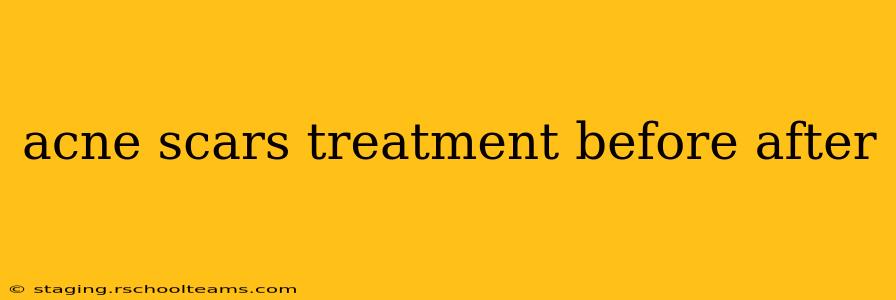Acne scars are a common concern for many, leaving behind blemishes that can impact self-esteem and confidence. Fortunately, numerous treatments are available, offering varying degrees of improvement. This comprehensive guide explores different acne scar treatment options, examines before-and-after results, and helps you understand what to expect from each approach. Understanding the nuances of scar types and treatment efficacy is crucial for making informed decisions about your skincare journey.
What Causes Acne Scars?
Before delving into treatments, it's important to understand why acne scars form. Acne lesions disrupt the skin's structure. Inflammation and damage to the dermis, the deeper layer of skin, can lead to scarring. The severity of scarring depends on several factors including the severity of the acne, the individual's skin type and healing process, and the depth of the acne lesion.
Different types of acne scars exist, influencing the choice of treatment:
- Ice Pick Scars: Deep, narrow, pitted scars.
- Boxcar Scars: Broad, square or rectangular-shaped scars.
- Rolling Scars: Wavy, uneven skin texture.
- Atrophic Scars: Depressed scars.
- Hypertrophic Scars: Raised, thick scars.
What are the Different Acne Scar Treatment Options?
Numerous treatments are available, ranging from minimally invasive to surgical procedures. Choosing the right approach depends on the type and severity of your scars, your skin type, and your budget.
Topical Treatments:
These are often the first line of defense, suitable for mild to moderate scarring.
- Retinoids: These vitamin A derivatives stimulate collagen production and cell turnover, improving skin texture and reducing the appearance of mild scars.
- Chemical Peels: These exfoliate the skin, removing damaged skin cells and stimulating collagen regeneration. Different types of peels offer varying depths of penetration.
- Topical Silicone Sheets: These sheets create a moist healing environment, potentially reducing scar redness and improving texture.
Minimally Invasive Procedures:
These procedures offer more aggressive treatment than topical options.
- Microneedling: This involves using tiny needles to create micro-injuries in the skin, stimulating collagen production and improving skin texture. Often combined with platelet-rich plasma (PRP) for enhanced results.
- Laser Resurfacing: Lasers target and remove damaged skin, stimulating collagen growth. Different types of lasers exist, offering varied levels of aggressiveness and suitability for different scar types.
- Dermabrasion: This procedure involves mechanically removing the top layer of skin to improve the appearance of scars.
Surgical Procedures:
Surgical options are typically reserved for severe scarring that doesn't respond to less invasive treatments.
- Subcision: This procedure involves surgically releasing the bands of tissue beneath the scar, improving the appearance of depressed scars.
- Punch Excision: This involves surgically removing the scar tissue and closing the wound.
- Fillers: These injections add volume to the depressed areas of the scar, making them less noticeable.
What are the Before & After Results Like?
Before-and-after photos showcasing the effectiveness of different treatments are widely available online and in dermatologists' offices. However, it's crucial to remember that results vary depending on several factors: the individual's skin type, the severity and type of scar, the chosen treatment method, and adherence to post-treatment care instructions. Generally, you can expect gradual improvement over time, with multiple treatment sessions often required for optimal results.
How Much Does Acne Scar Treatment Cost?
The cost of acne scar treatment varies significantly depending on the chosen treatment, the number of sessions required, and the geographical location. Topical treatments are generally the most affordable, while surgical procedures tend to be the most expensive. It's essential to consult with a dermatologist to get a personalized cost estimate.
What is the Recovery Time for Acne Scar Treatment?
Recovery time also depends heavily on the chosen treatment. Topical treatments typically have minimal downtime, while procedures like laser resurfacing or dermabrasion require a longer recovery period, potentially involving swelling, redness, and scabbing. Your dermatologist will provide detailed instructions regarding post-treatment care and recovery expectations.
How Long Does it Take to See Results From Acne Scar Treatment?
Visible improvements often begin weeks or months after treatment, with optimal results taking even longer. Patience and adherence to the treatment plan are crucial for achieving the desired outcome. Multiple sessions are often necessary to observe significant changes.
What are the Potential Side Effects of Acne Scar Treatment?
Potential side effects vary depending on the type of treatment. They can include redness, swelling, bruising, infection, scarring, changes in skin pigmentation, and pain. Your dermatologist will discuss the potential risks and side effects associated with each treatment option. Choosing a qualified and experienced professional significantly minimizes the risks.
This guide provides a general overview. Individual results and treatment plans will vary. Always consult with a qualified dermatologist or skincare professional to determine the best treatment approach for your specific needs and skin type. They can assess your scars, discuss treatment options, and create a personalized plan to help you achieve your desired results.
